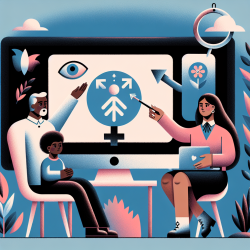In the ever-evolving field of speech-language pathology, understanding the nuances of communication disorders is crucial for developing effective therapeutic strategies. The research article "Segmented Analysis of Eye Gaze Behaviors of Fluent and Stuttered Speech" provides valuable insights into how eye gaze behaviors differ when individuals listen to fluent versus stuttered speech. This research has profound implications for speech therapists, particularly those working with children, as it offers a data-driven approach to improving therapeutic outcomes.
Understanding Eye Gaze and Stuttering
Stuttering is a complex communication disorder characterized by disruptions in the flow of speech. These disruptions can significantly impact the dynamics of verbal exchanges. The study conducted by Hudock et al. (2015) sheds light on how stuttering affects eye-gaze behaviors, providing a window into the emotional and communicative integrity of interactions.
The study involved 16 fluent college-age adults who observed video presentations of both people who stutter (PWS) and people who do not stutter (PWNS). Eye-tracking technology was used to measure the amount of time participants spent watching four regions of interest (ROIs): eyes, nose, mouth, and outside. The results revealed that participants spent significantly more time watching the eyes of PWNS and the mouth of PWS. Additionally, when viewing stuttered speech, participants focused more on the nose and mouth regions compared to fluent speech segments.
Implications for Speech Therapy
These findings have several practical implications for speech therapists:
- Enhanced Focus on Eye Contact: The study highlights the importance of maintaining eye contact during therapy sessions. Encouraging children to focus on the eyes of their communication partners can foster better emotional connections and improve communicative integrity.
- Addressing Negative Emotional Responses: The shift in eye gaze from the eyes to the mouth during stuttered speech indicates negative emotional responses. Therapists can work on strategies to reduce anxiety and tension in children who stutter, thereby improving their overall communication experience.
- Customized Therapeutic Approaches: Understanding the specific eye-gaze patterns associated with stuttering allows therapists to tailor their interventions. For instance, activities that promote relaxed and sustained eye contact can be integrated into therapy sessions.
Encouraging Further Research
While the study provides valuable insights, it also opens the door for further research. Speech therapists are encouraged to explore additional factors that influence eye-gaze behaviors, such as cultural differences, age-related variations, and the impact of different therapeutic techniques. By continuing to investigate these areas, practitioners can refine their approaches and develop more effective strategies for helping children who stutter.
Conclusion
The research conducted by Hudock et al. (2015) offers a compelling look into the relationship between eye-gaze behaviors and stuttering. By leveraging these findings, speech therapists can enhance their therapeutic approaches, ultimately creating better outcomes for children. Embracing data-driven strategies and fostering a deeper understanding of communication dynamics will pave the way for more effective and compassionate speech therapy.
To read the original research paper, please follow this link: Segmented Analysis of Eye Gaze Behaviors of Fluent and Stuttered Speech.










